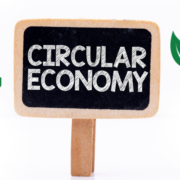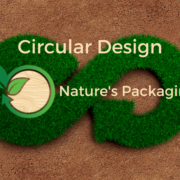Talking To The Source: Dr. Jennifer Russell of Virginia Tech and the Circular Economy – Part 2

*Editor’s Note: The viewpoint and statements of the following post may not reflect the views of Nature’s Packaging, however, we are always committed to providing an open forum for all members of the forest and forest products community.
What is value retention and how do we all stand to benefit from it?
In the past 100 years western culture and society has become normalized to the idea that products can just be ‘thrown’ away – that things have no value once we are finished with them. Our focus on convenience, variety, and an expectation of low-prices means that products once made to last 10 years (e.g. clothing) now cycle through retail stores and personal closets within only a few months. And global waste streams are exploding with these ‘unwanted’ items.
But if we think about the entire life-cycle of a product — from the extraction of the materials, it’s fabrication and manufacture, its use, and what happens when it is no longer wanted — you get a different perspective on the inherent value of the product.
Value can be related to the materials that are used, where they come from, how the products are assembled, who assembles it, how long it will last, and the variety of ways that it can be used, beyond the function that was originally intended.
Circular Economy challenges the us to find ways to extend product lives (e.g. make products last longer by designing them to be more durable, investing in maintenance, and finding opportunities to reuse, repair, refurbish, and even remanufacture them when they are no longer useful to the original owner).
Value retention is a fundamental shift in how we assess and understand the value of things – beyond price and brand – and thus, what we decide to do with those things when they are no longer wanted or needed.
Specifically, the Value Retention Processes that were studied in the UN Report relate to:
- reuse – where a product gets to serve an additional life providing functionality to someone else, instead of being directed to landfill.
- repair – where a product is returned to functionality for the original owner, through relatively smaller outlays of new materials, energy, and labor.
- refurbishment – where a product is brought back to full functionality, and potentially even upgraded to provide new functionality and performance for a new user.
- remanufacturing – a standardized industrial process where a product is fully disassembled, its component parts recovered and tested for quality, and those parts reassembled into a new product that meets or even exceeds the performance and quality standards for a new version of the product.
Through these activities, we can reduce environmental impacts, create employment and revenue opportunities, and continue to use products that provide important functions for individuals, businesses, and governments.
What are some of the barriers to change and how can they be overcome?
One of the greatest barriers to change right now lies in the attitudes and behaviors of individuals. We have been normalized to expect ‘new’, without realizing the environmental cost of that expectation.
We have also been conditioned to see reuse, repair, and multi-service lives as something that could be a significant risk, from economic, performance, and safety perspectives. A cultural focus on consumer convenience, immediate gratification, and low prices, makes it very difficult for consumers to make more sustainable decisions.
An example of this is the cost of repair: Many people opt to replace a broken product because the cost to have it repaired is actually higher than the cost of the product. That initial price comparison is typically as far as the decision-maker goes; other important factors that are usually not considered are that the independent repairer owns a local community business, is highly skilled, is trying to make a living, and can prevent ~95% of the product from going into the waste stream.
On the other side of the example is the low-priced new replacement product: the low-price is often a factor of overseas production, lower product quality, and shorter lifespan. What is a ‘good’ decision in this example, and how can the consumer legitimately gather all of the details needed to make the good decision?
Many organizations struggle to know how to make changes to be more circular, and to effectively communicate these opportunities to shareholders and stakeholders.
A feeling that “…if it ain’t broke, don’t fix it…” often keeps organizations locked-in to conventional processes and approaches; in other words, it can be hard to get organizations to make changes until there is a crisis, such as a major supply chain issue.
How do wood pallets fit into the circular economy model?
There are three main principles of circular economy:
- To minimize the waste associated with the production, use, and end-of-life of products and materials.
- To extend the productive/service life of products and materials, and thus increase the productive utilization over multiple service lives.
- To regenerate natural systems.
The wood pallet industry already practices circular economy in many ways; particularly for wood pallets that are designed to have multiple service lives (trips), and for which systems are in place to recover, evaluate, repair, and reuse those pallets.
For the first principle, many wood pallets are constructed from wood that is actually by-product of another wood manufacturing process – thus, waste from another process is used as the input to wood pallet manufacturing. There are many examples of repurposed wood pallets – once these pallets are no longer viable to serve as pallets, they are often integrated into alternative uses, instead of being directed to landfill as waste.
For the second principle, wood pallets are often recovered and repaired multiple times by wood pallet companies as part of the planned service life of the pallet – thus, the design of both the pallet and the system integrates repair over multiple use cycles, rather than requiring a new pallet every time.
Finally, wood pallets are constructed of a durable biomaterial that can be used to regenerate natural systems when they can no longer be used for anything else.
Many wood pallet companies choose to mulch the scrap wood materials that cannot be used any longer for pallets, and this mulch can be used in landscaping and biosphere applications – thus, enabling some of the embodied materials within the wood to be returned to the natural system, although it is important that this is only done with wood that has not been chemically treated.
Wood pallets are an excellent example of circular economy principles, in practice; an important thing for the industry to consider is how to more fully-embrace circular economy thinking, and where these systems can be further optimized and improved to reduce negative environmental impacts.






